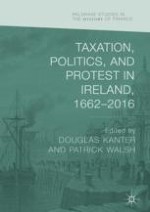2019 | OriginalPaper | Chapter
8. Taxation and the Economics of Nationalism in 1840s Ireland
Author : Charles Read
Published in: Taxation, Politics, and Protest in Ireland, 1662–2016
Publisher: Springer International Publishing
Activate our intelligent search to find suitable subject content or patents.
Select sections of text to find matching patents with Artificial Intelligence. powered by
Select sections of text to find additional relevant content using AI-assisted search. powered by
